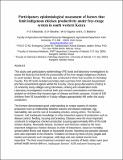| dc.description.abstract | This study used participatory epidemiology (PE) tools and laboratory investigations to assess the factor(s) that limit the productivity of the free-ranged indigenous chickens in south western Kenya. The study was conducted in three Sub-counties in Homabay County. The PE tools included secondary data summary from relevant Government and Non-Government agents within the County, Focus group discussions (FGDs) in 15 randomly study villages using interviews, ranking and visualization tools. Laboratory investigations involved both post mortem examinations and laboratory analysis on chickens that showed signs of disease and fresh carcasses. A total of 180 chickens from 55 households in 9 study villages appropriately fell under this study component.
The farmers demonstrated good understanding on certain aspects of chicken production such as relationship between seasons and disease outbreaks, egg hatchability rate and the size of incubating chicken, among others. The farmers, however, had inadequate knowledge on other important aspects of production such as disease control, feeding, housing and breeding. Diseases were the most important constraint to indigenous chicken production (causing approximately 80% of the total chicken deaths). Newcastle disease, Gumboro and fowl pox ranked as the most important indigenous chicken diseases in order of importance, based on mortality, spread within flocks and impact on household income. Bacterial and parasitic diseases were also important in the chickens. Predation of chicks by birds of prey (eagles and hawks) and animals such mongoose, wild dogs and cats ranked second most important. The third most important constraint was scarcity of feeds; others were poor animal health service delivery, inadequate farmers’ skills and poor housing and breeding, in order of importance. More importantly, this study identified Gumboro as one of the most important diseases that lower productivity of the indigenous chickens. Previously the disease was assumed to be important only in the exotic chickens. This study recommends that extension packages that enhance farmers’ knowledge and skills on appropriate management techniques in disease control, feeding, housing and breeding be initiated, developed and sustained. Likewise, the farmers’ useful knowledge on the indigenous chicken production identified and documented by this study should be considered in future strategies aimed at productivity improvement. | en_US |

